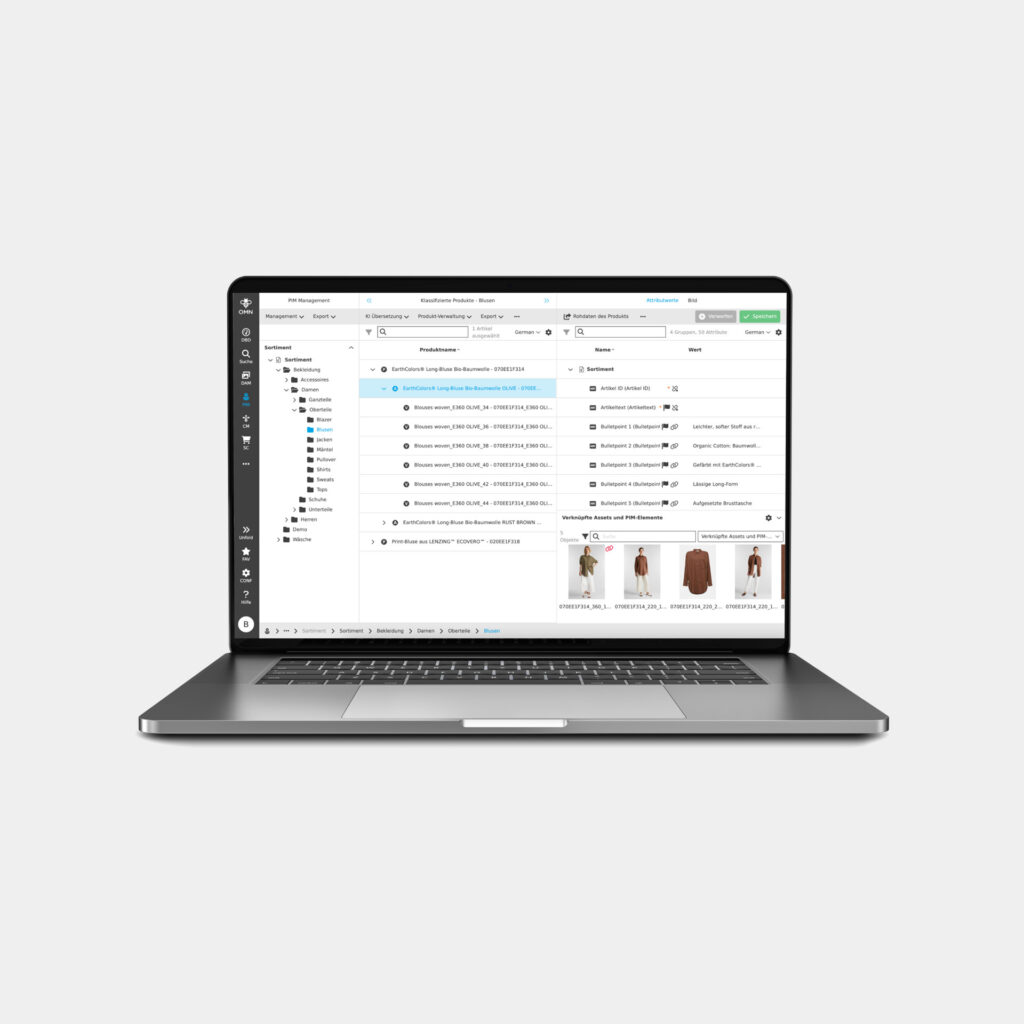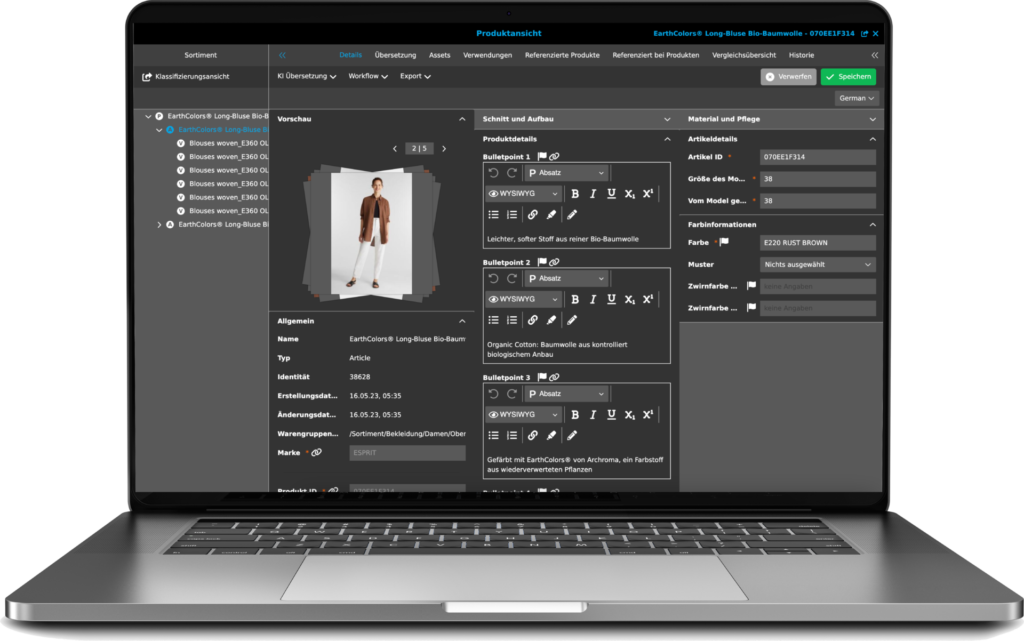Use of AI in PIM systems
Product Information Management
Artificial intelligence (AI) has also found its way into the world of PIM systems. But what does this mean and what exactly are the effects of AI? Dive into our blog post and discover which doors a PIM system with integrated AI can open for you.
Efficient management of product data is now beyond question, as it strengthens customer confidence through accurate information, ensures standardised brand communication and promotes operational efficiency through time and cost savings. It supports compliance, improves responsiveness to the market and increases online visibility. It also contributes to customer satisfaction and forms the basis for data-driven decisions and business growth. In short, online retail will not be able to survive in the long term without efficient product data management. In this context, a PIM system is now part of the standard technological repertoire of online retailers. And when a PIM system is topped off by the use of AI, the management of product data is raised to a new level of efficiency.

What is a PIM and why is it important?
A PIM system is software that is used to manage product data efficiently. To this end, a PIM system combines relevant data in a central location and enables all parties involved to enrich and update the product data together. The product data is then transferred to touchpoints (online shop, marketplaces, etc.) automatically and channel-specifically via interfaces. The centralisation and automation created by a PIM system ensure efficient processes, elimination of errors, faster time-to-market and better product experiences.
Use of AI in PIM systems: Concrete areas of application
Let’s be clear up front: Artificial intelligence is ineffective without data, because it needs it as a basis for its functioning. If you already have a PIM system but bypass it and don’t maintain any data in it, then you don’t need to invest in AI functions for your PIM. You can find out more about the importance of data in the following article: Data: The Centrepiece of every PIM system
Have items classified by the AI
Each product is characterised by specific attributes such as name, product ID, size, colour and weight, which make it unique. Classifications are used to facilitate the management of attributes by sorting the characteristics of a product into higher-level groups. This allows attributes to be found, edited or updated more quickly. This structuring also makes it possible to record only relevant attributes, which makes the process more efficient. However, classifying the articles can be time-consuming. Artificial intelligence offers a solution here by automating the allocation of products and product groups, thereby speeding up the process. And customers also benefit from this, especially when sorting or searching in an online store. This is because the classification ensures that only the relevant features are listed and that the customer always gets the best results.
Generate product texts with AI
Product texts can now be created automatically using text robots. For this, the NLG (Natural Language Generation) application only needs the product information from the PIM system in order to generate emotional product texts from this granular data (attribute values) quickly, cost-effectively and with a high variance. The result: Product descriptions generated in seconds that are also optimised for search engines. In this way, the AI not only relieves the burden of generating texts by creating emotional texts. AI also increases visibility and search engine rankings through SEO optimisation, thereby improving reach.
Transfer translations to the AI
Online business benefits from speed and lengthy translation processes have a counterproductive effect. Artificial intelligence provides a remedy here by translating approved product texts into the respective target language in real time. This automation not only saves time, but also costs, as translation tasks that were previously carried out manually by translators can now be completed with a single click. With AI support, language barriers are a thing of the past. The AI also takes cultural nuances into account, which enables localised product communication and makes it easier to tap into new markets. This means that nothing stands in the way of internationalisation.
Introduce hyper-personalisation
Hyper-personalisation is the next level of personalisation. It is a refined form of personalised customer approach and describes the comprehensive inclusion of all available information when communicating with customers (real-time and behavioural data). This makes it possible to provide each customer with customised content that is tailored to the type of buyer. This is realised with the help of AI, which combines the voluntarily shared customer data (e.g. via loyalty programmes, apps, etc.) with the respective product data. To do this, the AI analyses the purchasing behaviour and preferences of customers in order to make personalised suggestions that go beyond traditional “Customers who bought this also bought…” recommendations. The customer data can come from a CRM system or a Customer Data Platform (CDP), while the product data is supplied by the PIM system.
Recognising data inconsistencies through AI
Data quality is of crucial importance for companies. AI can recognise and correct discrepancies in the data using machine learning and natural language processing. It can identify duplicates, detect gaps in the product information and make suggestions for completion.
Offer product images according to context
Product images are decisive for purchases. After all, we are visual creatures and process information on the basis of what we see. For this reason, it is advisable to provide potential customers with product images depending on the context or use case. Meaning: Adapted to different lifestyles, a product image can convey far more about the products than generalised photos. Creating these can be challenging, but the use of AI can make this process much easier. For example, the AI can automatically remove the background from existing product images and replace it with a different environment (e.g. a bicycle in the city or in the mountains). Models wearing the garments can also be easily replaced with the help of AI. In the same way, the colours of an article can be changed with the AI without photographing the product in the other variant. AI-supported image processing offers numerous opportunities to reduce costs and increase the number of product images by photographing the product only once and then adjusting it depending on the context.
More efficient asset management
By combining PIM and DAM systems with AI technology, the management of digital assets such as images and videos can be made significantly more efficient. For example, AI-supported image recognition can automatically tag and categorise uploaded assets or suggest useful tags such as alt tags. The latter will become mandatory from 2025 when the European Accessibility Act comes into force in order to make almost all websites accessible. It is necessary that non-text content is provided with meaningful alt texts to ensure accessibility.

Final thought: Use of AI in PIM systems
Artificial intelligence has the potential to revolutionise PIM systems in many ways. It not only offers the opportunity to increase efficiency and accuracy in data management, but also to improve customer loyalty through personalised experiences. For companies, this means adapting more quickly to constantly changing market requirements and gaining a competitive advantage. In a world where data is the new gold, AI could be the key to fully utilising this treasure. But…
- As mentioned at the beginning, the integration of AI services is of little use if no data is recorded in the PIM system or the quality of the data is not good. Data is the be-all and end-all for AI, because if no product data is stored in the PIM system, no automated content can be generated from it (AI-based translations, product descriptions, etc.). The topic of data collection and data quality naturally also applies to all other systems, such as the CRM system (keyword: hyper-personalisation).
- If you want to benefit from the AI functions in the area of image recognition and image processing, then it makes sense to rely on a DAM system. Because only a DAM is created specifically for visual content and in this context is the perfect partner for PIM systems to correctly display texts with the corresponding images.
- Before you have different variants of product texts generated by AI, you should ensure that the PIM system is connected to the respective output channels. Only in this way can a seamless and automated transfer take place and AI be fully utilised.
- Before relying on AI, the legal regulations on data protection and data security, in particular the GDPR in Europe, should be observed. AI systems can process large amounts of data and it is important that this handling complies with legal requirements.
- The introduction of AI can change working methods. Prepare your team for the changes by organising training courses and information events. Support in adapting to new processes is crucial for successful AI integration.
Finally, it is crucial, especially if a PIM system is already in use, to test its ability to support AI-based functions. If this is not the case, then you should choose a provider with experience in integrating AI into PIM systems. The provider’s solid support and expertise are essential to effectively utilise the technology and overcome potential challenges in the field of AI. We are happy to support you with our OMN PIM.
About OMN PIM
OMN PIM is our in-house developed PIM system and already offers you a wide range of tried-and-tested AI services. In OMN PIM you can collect, structure and process product data from various sources. Regardless of whether the data comes from external or internal sources. Created specifically for product information, OMN PIM is therefore the ideal place for all your product data along the entire supply chain. Whether master data, specifications, materials, manufacturing processes or compliance details of products, OMN PIM bundles and links them all in a central location so that they can then be played out in the respective touchpoints in a channel-appropriate manner. By integrating various AI-based services (e.g. translations, text generation, classification and many more), OMN PIM gets the most out of automation and helps to minimise repetitive and non-value-adding tasks, freeing up resources for more strategic and value-adding activities. Get to know OMN PIM personally and let us convince you of the available AI services.

Would you like to see our PIM and the available
Get to know AI services?
HERE YOU CAN REQUEST A FREE AND NON-BINDING DEMO.